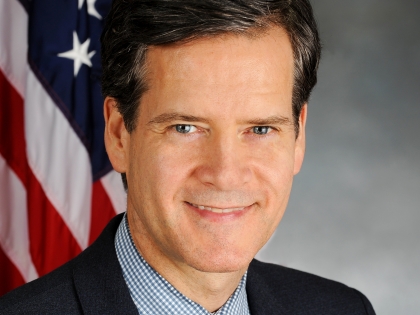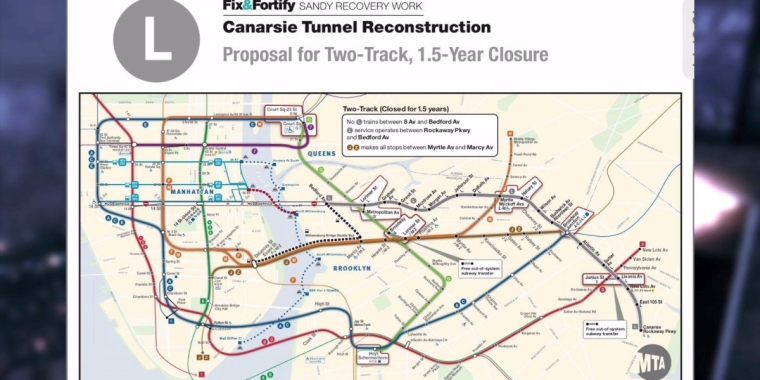
ELECTED OFFICIALS WIN REQUEST FOR TRAFFIC STUDY ON 14TH STREET DURING L-TRAIN CLOSURE
September 14, 2016

Study Will Examine Impact of Closing 14th Street to Vehicular Traffic to Accommodate Dedicated Bus Lanes, Pedestrians and Cyclists
NEW YORK – State Senator Brad Hoylman (D-Manhattan) released the following statement today in response to a letter received from the Metropolitan Transportation Authority (MTA) formally agreeing to his and his government colleagues’ request for a feasibility study on a plan to relieve congestion and improve traffic flow along the 14th Street transit corridor during the L-train closure.
“More than 50,000 people cross Manhattan daily on the L-Train below 14th Street. It’s crucial that we have a plan in place to accommodate these riders given the L-Train will be closed for 18 months starting in January 2019. I’m grateful the MTA has heard the concerns of riders, my colleagues and me and agreed to study the impacts of closing 14th Street to include the possibility of a dedicated bus lane and expanded pedestrian and cyclist access. I look forward to the results and partnering with the MTA, community boards, block associations, local businesses and other stakeholders to minimize the disruption from the Canarsie tunnel repairs.”
“I am really glad the MTA has positively responded to our letter and will now conduct a study of the potential closing of 14th Street for work on the L-Train,” said Congressman Jerrold Nadler. “The closing of the L-Train will be a huge inconvenience for commuters, and has the potential to create massive traffic, not only in Manhattan, but on bridges into the City from Brooklyn and elsewhere. We have to find better solutions for what likely will take over a year as we work to improve the L-Train, and I applaud the MTA for studying this issue.”
“I am thrilled that the MTA has taken the concerns of the community into account when planning for the L-Train closure,” said Congresswoman Carolyn B. Maloney (NY-12). “The L-Train along 14th Street services thousands of people every day, and we must have a viable plan in place to mitigate the inconveniences they will run into during the 18 month shutdown for repairs. Closing 14th Street, creating a dedicated bus lane, and expanding pedestrian and cyclist access are all great alternatives, and an impact study is an important first step to a comprehensive mitigation plan. We must ensure that the residents and businesses in the area have their needs met so that their day-to-day is not impacted too negatively. These repairs are necessary, but getting commuters to work and customers to businesses is equally important. I look forward to continuing to work with the MTA, my colleagues, and the community to ensure that the repairs move forward with as little disruption as possible.”
Rep. Nydia M. Velázquez (D-NY) said: “MTA needs to put serious thought into workable solutions that minimize disruption for commuters and all New Yorkers who use the L-Train. I’m pleased they have responded to our request examining these additional options for public transit riders.”
“It’s welcome news that New York City Transit has agreed to study the impact of the L-Train closure on 14th Street,” said Manhattan Borough President Gale A. Brewer. “Even though the closure is over two years away, it’s river-to-river impact on one of Manhattan’s most vital thoroughfares requires this kind of planning, and I’m glad the TA has agreed to start.”
State Senator Liz Krueger said: "Fourteenth street is arguably the most important thoroughfare in lower Manhattan, and it's imperative that we find a feasible solution to keep people moving across it--even when the L-train isn't. I'm pleased that the MTA has agreed to conduct a study on a comprehensive plan to mitigate the negative traffic impacts of this pivotal decision that affects thousands of New Yorkers."
“I am pleased that the MTA is willing to study the impact of the implementation of the L-Train shutdown,” said Assembly Member Richard Gottfried. “The MTA and the NYC Department of Transportation need to be sympathetic to the needs of real New Yorkers. We all agree this closure might be a nightmare for all involved. Therefore, to lessen the adverse impact, I urge all the parties involved to address the concerns and inconveniences to straphangers, local residents, area businesses; and plan to address emergency vehicles like ambulances, fire trucks, and police cars, as well as Access-a-Ride, and commercial and personal vehicles.”
"It will be a huge challenge to get by without the L-Train, but sometimes adversity can inspire great new ideas. I look forward to working creatively with colleagues in government and our communities to identify and implement the best options for getting people smoothly to and from Brooklyn and across Manhattan. Big changes on 14th Street are likely to be a key part of the solution," said Assemblymember Brian Kavanagh.
Assemblymember Deborah J. Glick said: "I am pleased that the Metropolitan Transportation Authority and NYC Transit will conduct a traffic study which is imperative to understand ways to alleviate the effects of the L train closure without creating additional problems. I hope that particular attention is paid to east-west through streets as any potential loss to the use of 14th Street will have outsized effects on vehicular traffic on surrounding one way streets. The L-Train closure will require the coordination of multiple City agencies and this is a positive step towards giving riders the best alternatives possible as the Canarsie tubes are repaired.”
“We need to explore every strategy to mitigate disruption caused by the shutdown and have an open dialogue with the community about what our best options are,” said Council Member Corey Johnson. “14th Street is one of busiest thoroughfares in Manhattan, and this shutdown is going to change the commute for a lot of New Yorkers. We need to come up with good options to ensure they’re not left behind during this necessary work. Right now, that means engaging with residents, businesses, the DOT and the MTA to make sure that all options that could help them are on the table and adequately reviewed.”
"We need to look at all possible ways to get people across 14th Street during the L-Train shutdown, and this is the first step in identifying solutions that will work for residents, commuters, and businesses along this corridor," said Council Member Dan Garodnick. "The MTA has made the right call in agreeing to conduct this study."
"The PeopleWay plan could double the capacity of 14th Street during the L-Train shutdown and beyond by prioritizing buses, biking and walking," said Paul Steely White, Executive Director of Transportation Alternatives. "We are encouraged that the MTA is taking an important first step by considering a bold plan to help stranded commuters and make this key corridor more efficient and sustainable. We hope the DOT will follow suit."
On June 6 Senator Hoylman and a group of local officials including Congressmembers Jerrold Nadler, Carolyn Maloney and Nydia Velázquez, Manhattan Borough President Gale Brewer, State Senator Liz Krueger, Assemblymembers Deborah Glick, Richard N. Gottfried and Brian Kavanagh, as well as NYC Council Members Corey Johnson and Dan Garodnick, sent a letter to the MTA requesting a feasibility study on the establishment of a dedicated bus route with expanded pedestrian and cyclist access on 14th Street during the L-Train shutdown. The letter requests the agency pay particular attention to potential effects on surrounding streets and access for 24-hour emergency vehicles, Access-A-Ride and other means of transport for seniors and people with disabilities. MTA is working with the New York City Department of Transportation and other agencies to plan for the future of the corridor.
